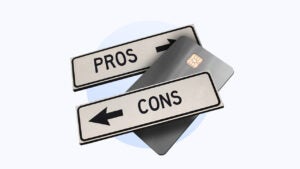2023 first-time credit card statistics




Key takeaways
- Nearly three in four Americans get a credit card by age 25, with the average balance being $5,221 for most consumers.
- Using credit cards can help you build your credit rating/score, provide rewards and perks, and serve as a safer form of payment than cash.
- Avoid getting into credit card debt by paying your credit card bills in full every month, avoiding overspending and making and sticking to a budget.
Credit cards can be valuable financial tools for spreading out large purchases over time, covering the cost of an emergency and earning the trust of lenders in the future when you need to borrow money for your first home or vehicle.
For many Americans, the credit-building journey begins in their teen years and continues throughout their lives as they learn to use credit cards responsibly and build their credit. The key is to start early and adopt responsible credit habits that will pay off in the long run. Your journey with plastic can be fantastic — provided you use credit cards responsibly and avoid getting into debt.
Read on to find out more about how credit cards work, what they can be used for, how to apply for a credit card, the different types of cards you may want to consider, how to stay out of credit card debt and more.
Key statistics on first-time credit cards
- 67 percent of U.S. adults ages 18-29 have a credit card (Federal Reserve)
- Getting approved for a credit card takes an average of 30 days or less (Bankrate)
- The average first-time credit limit is $500-1,000 (Bankrate)
- The average credit card balance is $5,221 (Bankrate)
- The average credit card utilization ratio is 28 percent (Experian)
- 31 percent of payments are made with credit cards (Federal Reserve Bank of San Francisco)
- 50 percent of Gen Z consumers — versus 32 percent of the entire population — are planning to apply for new credit or refinance existing credit within the next year (TransUnion)
- 64.8 percent of college students carry some type of credit card debt (College Finance)
- 44.7 percent of college students make the minimum payment each month on their credit card debt (College Finance)
Why do I need a credit card?
Using a credit card is a bit like taking out a short-term loan. You get approved by a credit card company to borrow up to a particular credit limit, and then you use the card to purchase goods and services up to that limit.
That said, credit cards serve a purpose beyond mere spending. They play a pivotal role in helping you establish a good, lengthy credit history. That’s important if you hope to get approved for loans, mortgages or other forms of credit in the future. Plus, using credit cards responsibly can increase your odds of being approved to make even larger purchases throughout your lifetime. By using credit cards, you gain supplementary spending capacity and the ability to fragment sizable expenses into more convenient monthly payments.
Another advantageous aspect of credit cards are their safeguards against fraud, a feature that isn’t usually as robust with debit cards. Notably, the prominent credit card networks (namely Visa, Mastercard, American Express, and Discover) commonly extend a $0 fraud liability assurance to cardholders.
“There are many other reasons why you might want to get a credit card,” says Andrew Lokenauth, a personal finance expert. “They can be used to make purchases anywhere in the world that accepts credit cards, which is helpful if you travel frequently or shop online. And many cards offer rewards, such as cash back, points for travel miles, for using your card.”
| Pros of having a credit card | Cons of having a credit card |
|---|---|
| Immediate access to funds | Easy to rack up credit card debt if you are not careful |
| Helps you build credit | Can hurt your credit score if not used responsibly |
| Ability to spread out large purchases over time | High interest rates if you carry a balance |
| Ability to earn cash back and rewards | Possible annual fees, cash advance fees, overdraft fees and foreign transaction fees |
| Greater fraud protection than debit cards | Vague approval requirements |
| Possible insurance benefits, including rental car and travel insurance | Can cut into your disposable income if you carry high balances |
There are several advantages and disadvantages to having a credit card. The most important benefit, however, is the pathway it creates toward a strong credit profile.
Why is a credit score important?
For lenders, landlords and even some employers, your credit can play a role in whether you are approved for an apartment rental, mortgage loan, job and more. This is why it’s important to protect your credit and manage it responsibly so you don’t put yourself in a position to lose out on your dream purchase down the line.
Keep in mind that if you don’t have a credit card yet and haven’t established your credit (or been added as an authorized user to someone else’s credit card), you will start with no credit score. Getting a FICO credit score generally requires getting and keeping a credit card account open for at least six months.
Here’s a rundown of what the average credit score looks like across various generations and income levels:
| Generation | Average credit score |
|---|---|
| Baby Boomers (58-76) | 736 |
| Generation X (42-57) | 699 |
| Millennials (26-41) | 680 |
| Generation Z (18-25) | 674 |
| Income | Average credit score |
|---|---|
| Lower Income | 658 |
| Moderate Income | 692 |
| Median Income | 735 |
| High Income | 774 |
How do credit cards work?
Credit cards are like an interest-free 30-day loan.
“They allow you to extend your finances for 30 days without penalty,” explains Cyndie Martini, CEO/founder of Member Access Processing, the nation’s largest aggregator of Visa card services for credit unions. “However, if you do not pay off your credit card charges within 30 days, the revolving debt incurs interest — usually at a high percentage rate.”
Your approved credit limit is the total amount you can borrow on your card. This gets reduced every time you make a charge; if your credit limit is $1,000 and you purchase something for $200, your remaining available credit is $800.
“A credit card grace period exists, which is the time between when you make a charge and when the bill is due. If you pay your card in full by the due date of each statement, your account will not accrue interest,” notes Jim Caniglia, senior vice president and consumer risk officer for UMB Bank. “If you pay anything less than the full monthly balance, your account is charged interest — which is based on your credit card’s annual percentage rate (APR). Your APR can vary and fluctuate over time, but the higher your credit score, the lower your APR or interest rate will be.”
The key to a successful credit journey is monitoring your spending. It’s important to be selective about your purchases with your credit card and either automate your payments or set reminders for yourself to avoid late or missed payments that could hurt your credit score.
Learn more: Credit card expert Ashley Parks gives her top 5 tips for first-generation credit users
What to use your credit card for
You can use a credit card to pay for many products and services, so long as your card is accepted by that provider, vendor or store. Many people pay for everyday expenses with credit cards, including groceries and gas. Here’s a rundown of some of the things you can pay for with credit cards.
| Item | Why use a credit card? |
|---|---|
| Rental car | Most rental car companies require a credit card in case of damages to the vehicle. |
| Hotel stay | Hotels will often require a credit card on file to cover the cost of incidentals, and hotel cards offer hotel discounts and perks. |
| Home repairs or appliances | Using a credit card will allow you to spread out these types of large purchases over time, making them more manageable. |
| Online purchases | Credit cards offer an added layer of fraud protection that other payment methods often don’t. |
| Travel expenses | Your credit card may offer rewards or discounts for travel-related expenses, as well as insurance if you need to cancel or postpone your trip. |
“Some of the things you are not allowed to use credit cards for include monthly rent or mortgage payments, taxes, some medical bills, and purchases so large that they will wipe out your available credit,” Martini says.
How to apply for a credit card
Applying for a credit card is relatively simple. Here are the common steps involved:
- Check your latest credit score. Your credit score will help you determine which cards to consider. You may be able to check your current credit score through your bank or financial institution. “A good credit score is considered 690 or above when applying for credit cards. But don’t be discouraged if your score isn’t in that range — you can try applying for cards with high approval odds,” Martini suggests. If you don’t have any credit history, you might opt for a secured credit card as a starter card while you work on building up your credit history.
- Shop around and compare credit card offers. Read the fine print to see what the minimum credit score requirements and the benefits/rewards included for each card are. Try to choose a card that charges no annual fee and a lower interest rate. The Schumer Box found in each credit card agreement will tell you the annual fee for the card you’re interested in, the APR, penalty fees and other charges.
- Try to get pre-approved/pre-qualified first. “If you desire a particular credit card, you can always apply for it online or through the mail. But you have a better chance of getting approved if you are pre-approved for that card, which you may be able to do online by going to that card issuer’s website,” continues Martini.
- Gather all of your documents and information ahead of time: Most applications will ask you for key information like your Social Security number and annual income. Have this information readily available when you set out to apply.
- Complete your application: You have a few options for completing your credit card application. You can visit the issuer’s website, apply in person if the issuer has a physical location near you, apply over the phone or send in your application through the mail.
- Wait for approval. Credit card issuers will verify your identity and the personal information you provide, which will help them determine if you will be approved and what your credit limit will be. “The credit card company will review your application and decide whether or not to approve you. If you are approved, you will receive your credit card in the mail within a few weeks,” says Lokenauth. You might get a decision immediately, but more likely you’ll receive their verdict within 10 to 14 business days after submitting your application.
Note that your credit score will take a minor hit after you apply for a new credit line, but this should be a temporary score drop that will rise back up with proper credit card usage.
Types of credit cards
There are several types of credit cards you may want to consider. Here’s a breakdown:
- Student credit cards. Some credit cards are geared specifically to the needs of students and offer perks such as automatic credit limit reviews and credit education resources.
- Secured credit cards. If you’ve never had a credit card before and lack a credit history, you may find it difficult to get approved for a traditional credit card. If so, a good starter option is a secured credit card, though you’ll need to put down a deposit to serve as collateral for purchases you make using the card. “If you default on your payments, the card issuer keeps your deposit. The good news is that, even if you don’t have great credit, you can get approved more frequently and it can actually help raise your credit because it reports your payments in your credit reports,” Martini says.
- Unsecured credit cards. These cards represent most traditional credit cards and are available to those with good to excellent credit. Unlike secured cards, they do not require a security deposit, but they usually have higher interest rates.
- Cash back and reward cards. Cash back and rewards cards reward you in the form of points that can be redeemed for merchandise or services or cash that represents a small percentage of each purchase you make, such as 1 percent to 5 percent. Cards like these often have no or low annual fees and introductory offer incentives like 0 percent APR for a limited time.
- Travel or frequent flyer cards. With a travel rewards card, you can earn travel rewards points, often with a specific hotel chain or airline. Other perks can include free hotel stays, complimentary seat upgrades, priority boarding, airport benefits and free checked baggage.
- Department store-branded cards. These cards are offered by several big box and online retailers, including Home Depot, Target and Amazon. Some can only be used at that particular store, such as the Kohl’s credit card. The advantage of these cards is that you can take advantage of discounts or rewards from that store; however, they often carry higher-than-average interest rates and offer smaller bonuses than you may receive from general-use credit cards.
How to avoid credit card debt
If you’ve never owned or used a credit card before, it’s crucial to understand how easy it can be to overcharge beyond your means to repay your debt punctually.
“It’s very important to make your credit card payments on time, regularly check your credit score and ensure your three free credit reports are reflecting fiscal responsibility and care,” suggests Caniglia.
Aim to pay your balance due in full each month before the deadline indicated on every credit card statement you receive. At the very least, make the minimum payment due on your credit card every month. This will help you avoid late fees and costly compounded interest charges that will dig you into a deeper debt hole.
Caliglia adds that it’s also wise to “create a realistic budget that should be tailored to your specific financial needs, annual income, amount you are spending or have spent and how much you have put into savings.”
If you find yourself in credit card debt and are concerned, create a plan to pay off what you owe as quickly as you can.
“Seek help from a credit card counselor if necessary. This expert can consolidate debt for multiple cards into one payment with a lower interest rate,” suggests Martini. “Or, you can try negotiating directly with card issuers and explain your extenuating circumstances.”
The bottom line
When used carefully and sensibly, credit cards provide several benefits — including a convenient form of instant payment, fraud protection, the ability to grow your credit history and rewards, cash back, discounts or other perks. Take the time to choose the right card for your needs and be careful not to charge more than you can afford to repay on time.
“Read the terms and conditions of your credit card agreement carefully before you sign up. Be aware of any fees associated with the card, such as annual fees, late payment fees and foreign transaction fees,” advises Lokenauth. “Also, regularly keep track of your card spending to make sure you don’t exceed your credit limit or ability to pay back your debt.”





